Blog
Blog
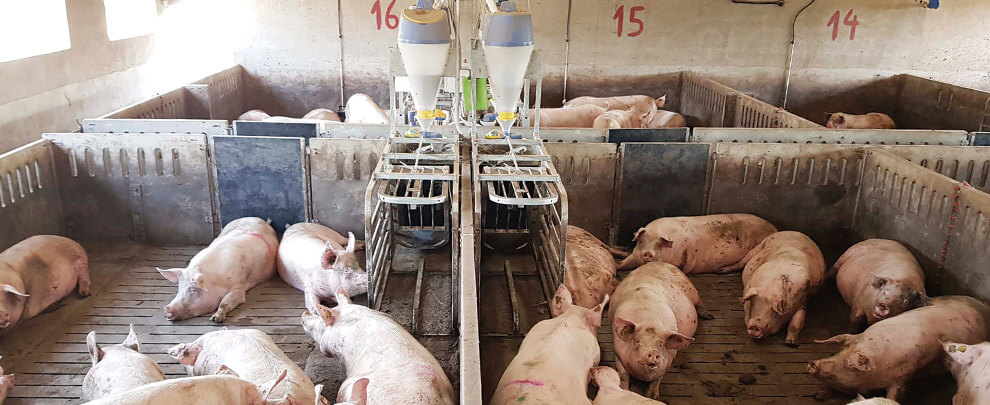
Keys to feeding gestating sows
10 of January of 22 - Studies
Josep Rius. Rotecna R+D Department.
Incorporating precision feeding technologies applied to pig farms is a common practice. Its advantages are obvious, but it is still a tool that must be used so that its final recipient, livestock, receives its benefits as an improvement in their diet. The well-employed virtues of electronic feeding systems are beneficial to both the farmer and the livestock in his care. However, both recipients must benefit equally from its capabilities and not forget that electronic feeding offers the possibility of feeding each of the animals on the farm in a completely individualised and automated way. This creates an opportunity for new feeding prospects for farmers who implement a system of this type for the first time.
Electronic feeding is a means to offer food in which the person responsible for feeding pregnant sows has a set of options to configure a strategy according to the needs of their animals. How do we know that a pregnant sow is receiving the right ration? The weight and body condition goals determine the answer at the birth we have set. It is easy to set the goal, but it is no longer so easy to reach it without going overboard or falling short. Often, we do not have reference points, or we do not know the weight and reserves that the sows have lost during lactation, and that makes it even more difficult. It is difficult to reach a goal without knowing our starting point
Sows’ characteristics
The current sow lines are genetically selected for lean production, growth speed, feed efficiency, greater prolificacy, and increased dairy capacity. On the downside, the capacity of voluntary intake in lactation decreases, the weight gain in the growth phase is increased and, therefore, the body weight in the following cycles, besides losing in rusticity. Therefore, it is important to control the conditions in which the young sow enters the reproductive and productive cycle, maintain moderate growth throughout the first two or three productive cycles, and properly manage the variation of body reserves throughout the successive cycles.
Faced with this type of sow, it is even more necessary to know in the most objective way possible the increasing and decreasing progression of body reserves throughout gestation and lactation, respectively. There are different systems to control the condition of their physique, such as visually, using scales (the typical scale of 1-5 or 1-4), weighing the animals, using a dorsal fat meter or a measuring tape to measure the length from side to side, among others.
Disadvantages of an excessive body condition
- Increased number of dead piglets.
- Lower production of colostrum and milk.
- Increase in the percentage of discard (locomotion).
- Increase in the percentage of mortality of piglets.
- Low weaning weight and long weaning-heat interval.
Disadvantages of low body condition
- Lower birth rates, more abortions, and a decreased number of piglets.
- Low birth weight and a higher percentage of stillbirths.
- Lower production of colostrum and milk.
- Increase in discard percentage (shoulder injuries, lack of pregnancy, repetition, locomotion).
How to design a feeding plan for pregnant sows?
To design a feeding plan that allows us to recover and prepare the sows for the next delivery, we must analyse multiple factors and interrelate them with each other, to get an as fine-tuned as possible approximation, to the real nutritional needs of the animals. In a simplified way, it is necessary to perform:
- Productive characterisation of the farm.
- Characterisation of the sows’ growth.
- Adjustment of the curve to the requirements.
- Gestation curves to recover body condition.
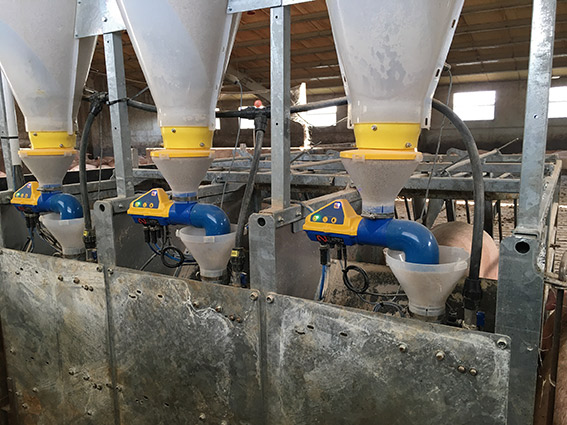
You have to establish the amount of feed for each curve. Photo: Rotecna.
Once the characterisation of the productive and growth results has been carried out according to the farm’s genetics, we can adjust the curve to the energy, protein, minerals and vitamins, requirements, and generate the different curves taking the body condition and weight of the sows into account. Then, at the beginning of gestation, you just have to select the sows for each of the curves and establish control points throughout the gestation, in which the recovery, growth and replacement is evaluated, if it corresponds to what is expected or desired. It is necessary to consider the recommendations of the genetics provider of the farm (always adapted to their characterisation) because they offer a guide or classification of body conditions (usually expressed in mm of dorsal fat to P2) and the best way to prepare their animals. However, as the characteristics of each farm are unique, each one (or each group of farms of the same company with similar peculiarities) should have a feeding strategy adapted to it depending on the experience, tests, and results analysis that have been carried out.
Following this feeding model, we are going to simulate a scenario of how curves should be made (Table 1 and Graphic 1).

Table 1: Example of how the curves should be made.
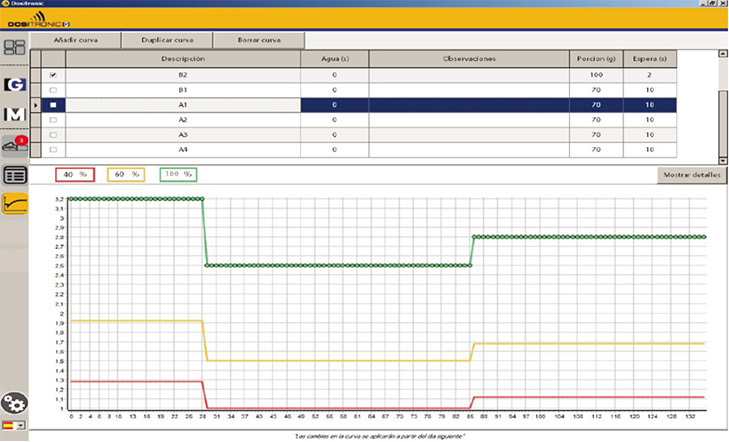
Graphic 1: Example of curves configured with Dositronic G.
First, we are going to divide the gestation into three typical periods:
- Recovery (0-28 days): It is essential to improve the physical condition after the weight loss produced in the delivery unit, since a negative energy balance decreases embryonic survival and increases the risk of abortion.
- Maintenance (29-84 days): Once improved, the sow must grow moderately or be sustained.
- Growth (85-108 days): The nutritional needs of sows increase because of their breast and litter development.
Second, we will set the food amounts, taking the weight and dorsal fat for each of the periods of gestation into consideration. The goal at delivery is 16-18 mm of dorsal fat.
As we know, there are different methods of monitoring body condition more subjectively or intuitively, such as visually or scaled, which are easy to apply, but less precise and effective. If used, it would also be important to combine visual or scoring perception with at least the sow’s size or cycle to take this into account when creating and assigning feeding curves (Table 2).
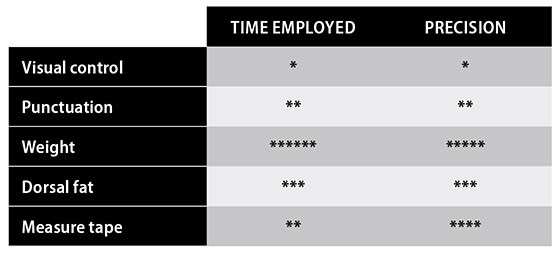
Table 2: Comparison of body condition control systems.
How to apply meal plans with Dositronic G?
Once the feed amount of each of the curves has been established, we must decide how and when to apply them. The Dositronic G electronic feeding system can be used in pregnancies with:
- Post-inseminated sows that will be transferred to group gestation pens, where the curve adapted to their weight and body condition must be chosen.
- Sows with 28-35 days of post-insemination will be transferred to group gestation pens from the control group, where the curves adapted to their weight and body condition must be selected. Depending on the level of recovery achieved, we will apply a condition (*) -increase or decrease of progressive feed during the days established on the curve associated with the sow to which the condition is applied- or the curve that we believe best suits each of the sows.
(*) Conditions can be reconfigured or recreated depending on the need. For example: upon entering a sow into the Dositronic G system, we apply a curve that, for days of gestation (33), is already in the maintenance period, but the sow is not as recovered as we would have liked. A condition is applied with a progressive increase of 15 days until reaching 20% more of the amount of feed allocated in the curve and a decrease of 5 days.
In both cases, periodic body condition checks are recommended to assess whether the pre-set objectives are achieved. The control of the body state before calving is essential to check if the feeding strategy chosen for each sow during gestation was correct.
Conclusions
We have included two body condition monitoring systems because it is important to remember that the amount of energy required for upkeep will rise with the sows’ weight increase and additionally, dorsal fat is an indicator of the reserves that the animal has. These are two elements that are usually lost or mobilised during lactation and, therefore, logically, they are the ones that we need to take into account as a starting point from where we recuperate and prepare the sows in the most effective way possible (Graphic 2).
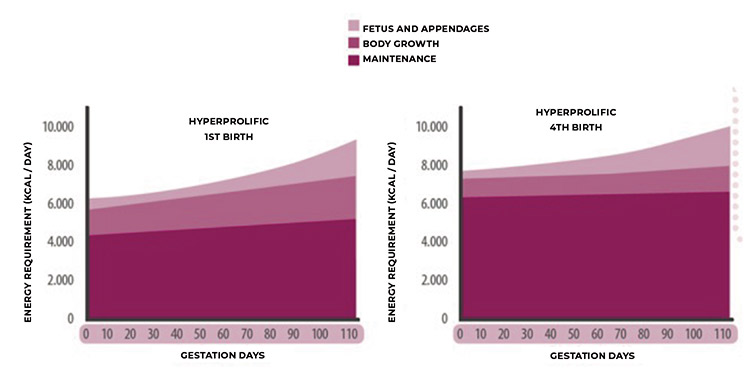
Graphic 2: Differences between the energy requirements throughout the gestation of a young sow and an adult sow.
Some scientific studies suggest that this method, compared to others without objective body condition control or weight estimation, results in savings in feeding costs. Likewise, the repercussions of achieving uniformity of body condition at calving entail, in the first place, having sows with more capacity to achieve high levels of feed intake and milk production in lactation and consequently more piglets and weaning weight. Second, we will get sows with less mobilisation of reserves during lactation, fewer days to go into heat once weaned and more prolificacy and weight of the piglets at the next birth.
Applying this feeding system, which efficiency is its primary aim, and that classifies the physical condition of each sow to feed it, is not feasible in farms of a certain size with non-electronic systems. This is one of the significant advantages of electronic systems: the ease of applying an “à la carte” feed curve, ensuring each sow will receive the precise amount of food it needs.






